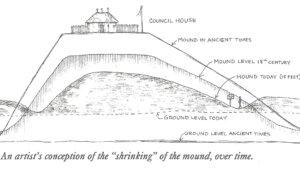Nearly 3 million people hike on some part of the Appalachian Trail annually, and about 3,000 of those individuals thru-hike the 2,197.4 miles from Georgia to Maine. While they walk, few have any idea they are encountering an important, yet little-known aspect of American history. While some misshapen trees along the southern part of the trail, mainly in Georgia, North Carolina, and Tennessee, may simply be the result of age and wind, there’s a good chance some are leftover symbols of a past trail system used by native peoples—especially Cherokee, Catawba, and Creek.

Tree-PS, not GPS
In fact, long before an expansive network of interstates and highways cut across America, Native Americans formed and traversed trails that they used regularly for trading goods, hunting, and gathering, as well as to make war against opposing tribes, settlers, and British forces.Native Americans used these trees to mark a network of trails much like how printed road signs provide information today. Depending on how trees were bent, they indicated the location of water and food, marked culturally significant landmarks like burial sites, and warned of dangerous areas.
These trees are known by several names. Trail trees or trail marker trees are the two most common monikers, but they’re also called signal trees, thong trees, and prayer trees.
Elm, oak, and maple were the species most often chosen to mark trails but such species as beech and others were used. Saplings were chosen because of their flexibility. When these hardwoods matured, they kept the intended shape.

After the sapling grew for a year or more, the weights, stakes, or ropes were removed. The tree’s trunk didn’t right itself because the bark and wood had hardened. The tree was then trained to grow upright by tying off the leader, which is the vertical stem at the top of the trunk. Sometimes, another tree in proximity was also manipulated so that together, the two trees specified directions or information.
Although meanings of the trail markers were passed down orally, experts speculate on what they indicated: three trees together with a specific limb pointing straight out and then straight up indicated a new trailhead; two trees with one limb slightly higher on one tree than the other meant to turn in the direction the manipulated limbs was pointing, and that one bent tree meant to continue in the direction of the distorted limb.
Modern observers often find it difficult to identify trail trees. But there are clues. If a tree’s trunk goes straight up, makes a sudden right angle turn parallel with the ground, and a limb extends sharply up again in another 90 degree turn (instead of angling or curving naturally), it could be a tree uniquely shaped for use as an age-old landmark.
Trail marker trees are not only found along the Appalachian Trail; they exist along the Bartram Trail in North Georgia and Western North Carolina. They’ve have been recognized in plenty of other states as well, including Illinois, Indiana, Kentucky, Michigan, Missouri, Ohio, and Wisconsin. One trail tree in Traverse City, Michigan is so revered that it is protected by a fence in the city’s Civic Center Park and features a rock with information about the tree’s history.







